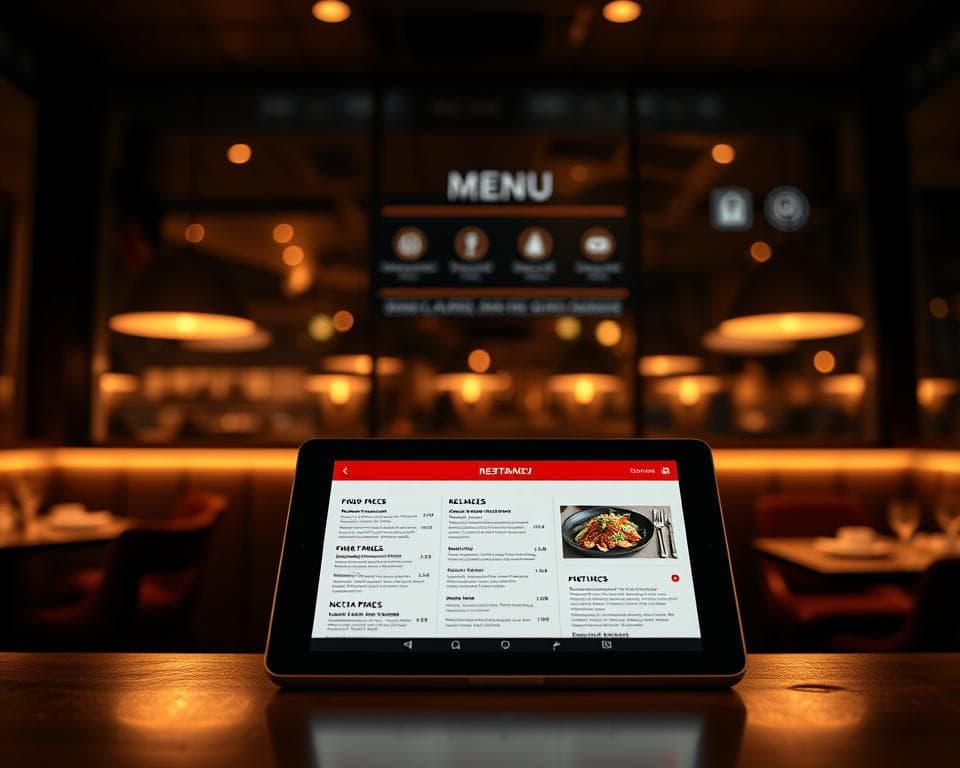
The restaurant world is changing fast, moving towards digitalization. Digital menus are now key to the dining experience. People want easy and smooth interactions with restaurants. This makes UX design in digital menus very important.
A good digital menu makes dining better and ordering easier. It makes customers happy. By using UX principles, restaurants can make digital experiences better. This boosts customer happiness and loyalty.
Key Takeaways
- UX design plays a key role in making digital menus smooth.
- Custom menu options can make the experience better for customers.
- It’s important to show clear prices and allergen info to build trust.
- A menu in many languages can help sell more during busy times.
- Keeping digital menus up-to-date can help avoid legal problems.
The Evolution of Restaurant Menus in the Digital Age
The restaurant world has changed a lot. Now, menus are digital instead of paper. This change comes from new tech and what people want, making eating out more fun and personal.
From Paper to Pixels: The Digital Transformation
The move from paper to digital menus is part of a big change in the restaurant world. Digital menus bring many benefits, like:
- It’s easy to change menu items and prices
- They make customers more involved with interactive features
- They save money on printing and handing out paper menus
Experts say digital menus and table reservations are not just a trend. They’re a must for restaurants to keep up. This move to digital menus will keep growing because people want easier and more personal dining.
Impact of COVID-19 on Menu Digitization
The COVID-19 pandemic made restaurants quickly switch to digital menus. This was to cut down on contact and follow health rules. Digital menus are now key for being flexible and adaptable.
COVID-19’s effects on menu digitization include:
- More use of QR code menus
- More focus on online ordering and delivery
- More use of digital payments
The pandemic showed that restaurants with strong digital systems do better in tough times. This proves the worth of investing in digital solutions.
Core UX Principles for Effective Digital Menus
User experience (UX) design is key for digital menus. A good digital menu makes dining better. It helps customers easily find what they want.
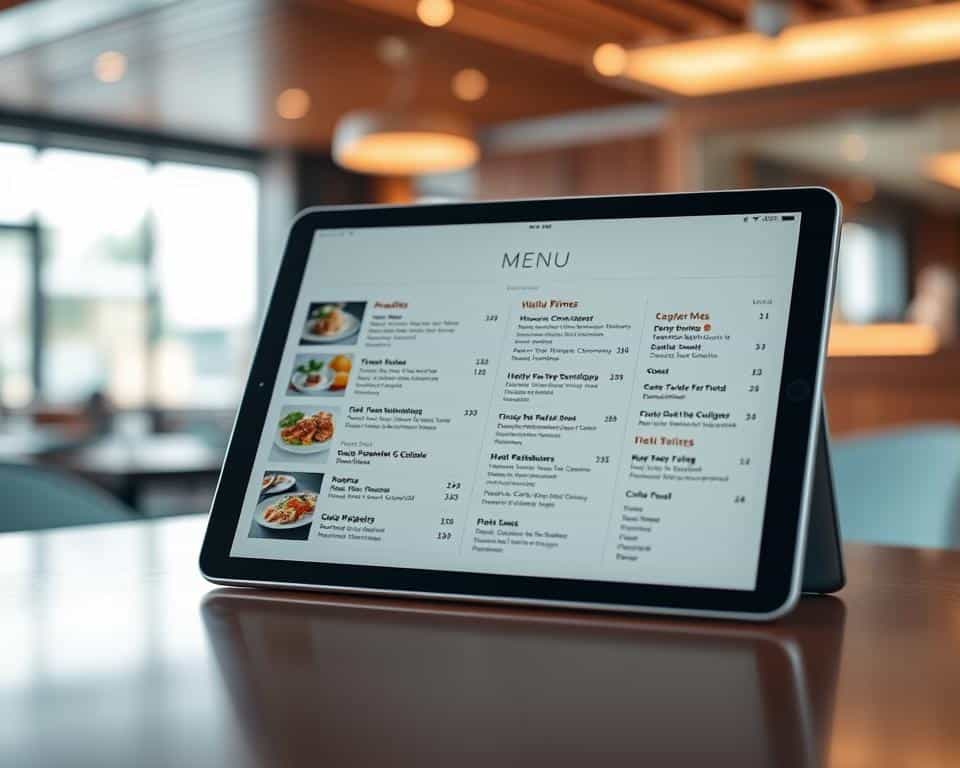
Clarity and Simplicity in Design
A simple design is important for digital menus. Use easy-to-read fonts and colors that don’t hurt your eyes. Clutter-free layouts and short descriptions help users quickly look through the menu.
Intuitive Navigation Patterns
Easy navigation is essential. Use patterns users know and organize the menu well. “Navigation UX Design: Best Practices, Types & Patterns” shows how this improves user happiness.
Consistency Across Touchpoints
Being consistent is key for a smooth experience. Make sure the menu looks the same on the website, app, and in-store. This strengthens the brand and makes it easy for customers to use the menu on any device.
By following these UX principles, restaurants can make digital menus that attract and satisfy customers.
Understanding Your Restaurant’s Digital Customer Journey
In today’s world, knowing the customer journey is key for restaurants. It’s about every online interaction, from looking at the menu to booking a table.
Identifying Key User Personas
First, restaurants need to find their main user personas. They must know who their customers are, what they like, and how they act. By making detailed personas, restaurants can make their online presence better for their customers.
Mapping Customer Touchpoints
After finding the personas, restaurants should map out customer touchpoints. This means looking at all interactions, both online and in person. For a full picture, they can use this guide on customer journey mapping. This helps restaurants see where they can get better and improve the experience.
Addressing Common Pain Points
Common problems include hard-to-use sites, slow loading, and unclear info. Restaurants can fix these by making their site easy to use, fast, and clear. This makes customers happier and more loyal.
Visual Design Elements That Enhance Digital Menu Experience
A good digital menu is more than looks. It makes dining inviting. Visual design grabs attention and shapes what customers choose to eat.
Typography and Readability Considerations
Typography is key in digital menu design. It helps customers read and get the menu. The right font can make a big difference in the dining experience.
Font Selection for Different Devices
Choosing the right font is important. It should be clear on all devices. Sans-serif fonts like Arial or Helvetica work well for menus.
Text Hierarchy and Emphasis
A clear text hierarchy guides the customer. Different font sizes and colors highlight dishes or deals. This makes the menu more interesting.
Color Psychology for Appetite Stimulation
Colors can make us feel certain ways and even make us hungry. Warm colors like red and orange are used in food branding. They make us feel more energetic and hungry.
For example, a table shows how colors affect appetite:
| Color | Emotional Response | Appetite Stimulation |
|---|---|---|
| Red | Increases heart rate, energy | High |
| Orange | Evokes warmth, excitement | Moderate to High |
| Green | Associated with freshness, health | Low to Moderate |
Effective Use of Food Photography
Good food photos make the menu better. They make dishes look appealing and help customers imagine their meal. This can lead to more sales.
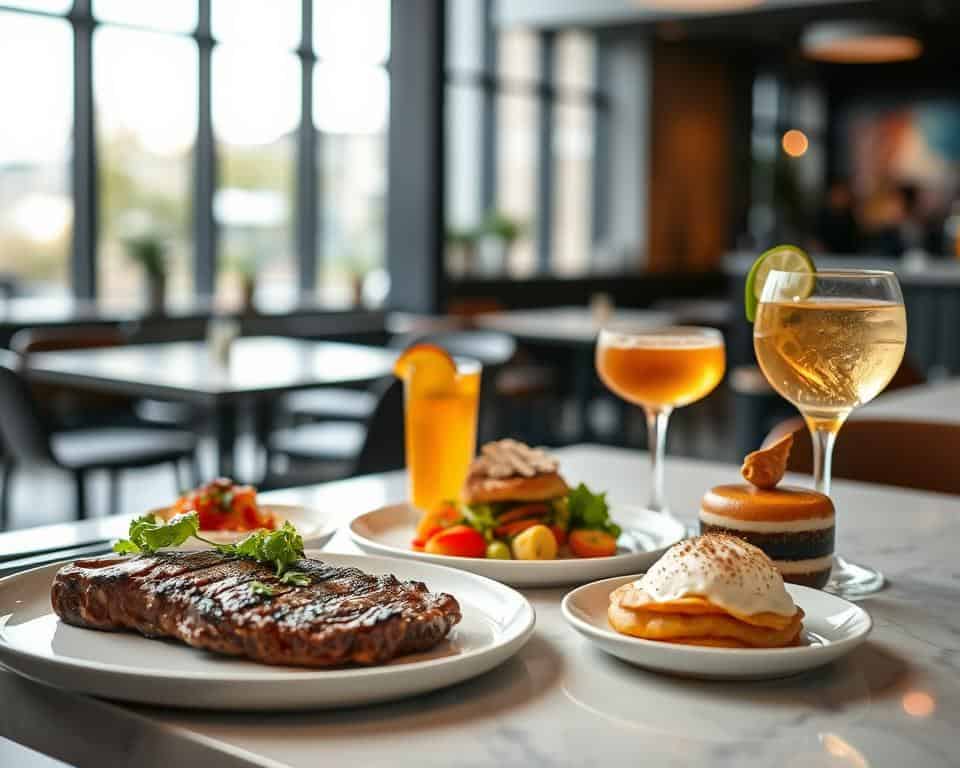
Using high-quality images that load fast is important. This keeps the menu experience smooth.
Visual Storytelling Through Images
Images can tell a story about the dish. They show what’s in it and how it’s made. Good visual storytelling connects with customers, making dining more personal.
Information Architecture for Digital Menus
The backbone of a user-friendly digital menu is its information architecture. A good design makes it easy for customers to find what they need. This improves their dining experience. Restaurants organize their menu in a way that’s easy to use and appealing to their audience.
Logical Menu Categorization
Organizing menu items in a logical way is key. Restaurants group similar items together. This makes it easier for customers to find what they want.
For example, grouping items by course or dietary preference helps a lot. To learn more about the importance of information architecture, visit understanding information architecture.
Search and Filter Functionality
Having good search and filter options is important for digital menus. It helps customers find specific dishes quickly. They can filter by price, dietary restrictions, or cooking method.
This makes it easier for customers to find what they want. It also makes them happier with their experience.
Displaying Nutritional Information and Allergens
Showing nutritional info and allergens is a must in many places. Digital menus are a great way to share this info. It helps customers make better choices about their meals.
By showing this info clearly, restaurants can meet different dietary needs. This shows they care about their customers’ health and preferences.
Integrating Digital Menus and Table Reservations Seamlessly
Restaurants are now focusing on creating a unified customer experience. They do this by integrating digital menus and table reservations. This makes the dining experience smooth and efficient.
Creating a Unified Customer Experience
A unified customer experience means all parts of dining are easy and connected. This happens when the digital menu and reservation system work together. Customers can easily go from looking at the menu to booking a table.
| Feature | Benefit |
|---|---|
| Integrated Menu and Reservations | Streamlines customer experience |
| Real-time Availability | Reduces no-shows and improves planning |
| Personalized Recommendations | Enhances customer satisfaction |
Cross-Platform Consistency
To ensure a cross-platform consistency, restaurants must make their digital menu and reservation system work on all devices. This means the website, mobile app, and in-restaurant tablets should all offer the same smooth experience.
From Browsing to Booking: Streamlining the Process
It’s important to make the process from browsing to booking easy. By letting customers book directly from the digital menu, restaurants can get more bookings.
By integrating digital menus and table reservations, restaurants can make dining better. This leads to happier customers and more loyalty.
Mobile Optimization Strategies for Restaurant Digital Menus
Mobile browsing is on the rise. Restaurants need to make their digital menus easy to use on phones. This is key for reaching more customers online.
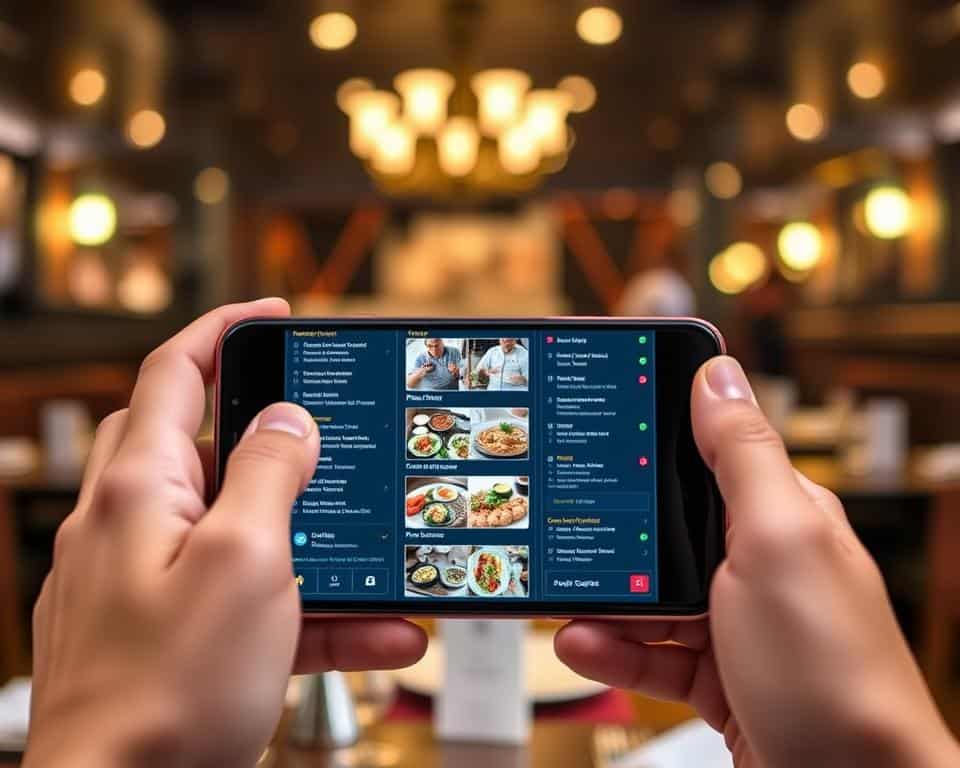
Responsive Design Principles
Responsive design is key for mobile menus. It makes menus work well on all devices. This means the menu looks good on phones, tablets, and computers.
Responsive design helps restaurants offer a great experience. It keeps customers happy and engaged. This can lead to more orders.
Touch-Friendly Interface Elements
A good mobile menu is easy to use. Restaurants should make sure their menus are simple to navigate. This means big buttons and clear menus.
Intuitive gestures like swiping help too. They make the menu fun to use. This encourages customers to explore and order.
Performance Optimization for Various Devices
Fast menus are important. Restaurants should make their menus quick to load. This means optimizing images and files.
Fast menus keep customers interested. They lead to a better dining experience. This builds loyalty.
Accessibility Considerations for Inclusive Digital Menus
Accessibility in digital menus is now a must for restaurants. It ensures all customers, including those with disabilities, can enjoy dining without barriers.
WCAG Compliance for Restaurant Websites
WCAG (Web Content Accessibility Guidelines) compliance is key for accessibility. It makes sure the website and digital menu work for everyone. It’s not just about avoiding legal trouble; it’s about welcoming all customers.
Screen Reader Compatibility
WCAG compliance means digital menus must work with screen readers. This lets visually impaired customers ‘read’ the menu with assistive tech. Restaurants can make sure screen readers work well by organizing content well.
Keyboard Navigation Support
Providing keyboard navigation support is also vital. It lets customers without a mouse use their keyboard to navigate. This makes the menu more accessible for those with mobility or dexterity issues.
Designing for Users with Disabilities
When making digital menus, think about users with different disabilities. This includes visual, auditory, motor, and cognitive disabilities. Understanding these needs helps create menus that are welcoming to everyone.
Multilingual Support for Diverse Customers
Offering menus in many languages is also important. It lets restaurants reach more customers, like tourists and locals who speak other languages. Simple language options on the website or menu can help.
By focusing on accessibility and inclusivity, restaurants can improve the dining experience for all. This builds a loyal customer base and helps create a more welcoming community.
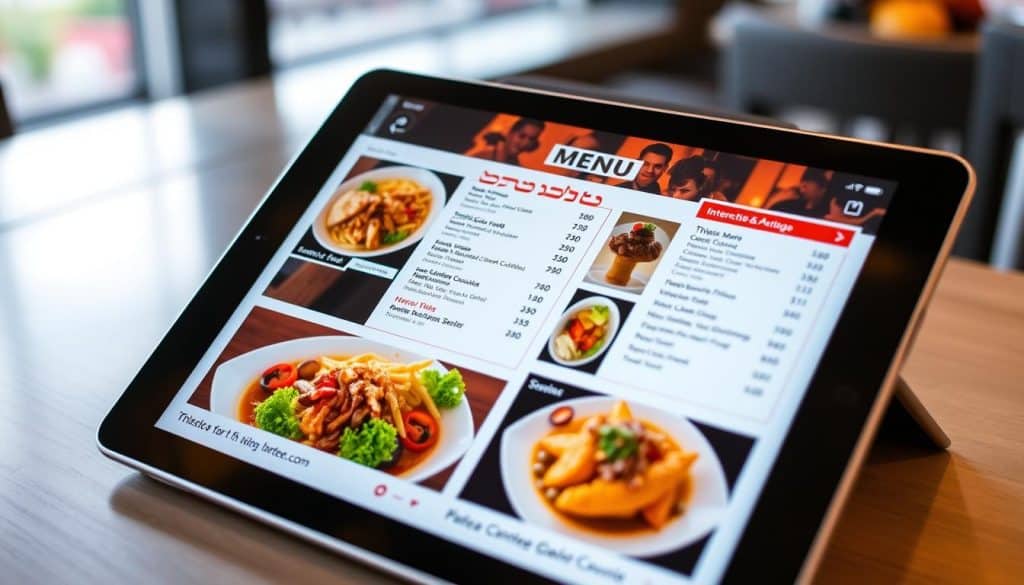
Testing and Iterating Your Digital Menu Design
User testing is key to making a digital menu that customers love. By getting real users involved, restaurants can learn how their menu works. They can also find ways to make it better.
User Testing Methodologies
Restaurants have a few ways to improve their digital menu. A/B testing and usability testing are two good methods.
A/B Testing Key Elements
A/B testing compares two menu versions to see which one works best. It looks at layout, item descriptions, and buttons.
Usability Testing Sessions
Usability testing lets you watch users interact with the menu. It shows what they think and what they struggle with.
Analyzing User Behavior and Feedback
After testing, it’s important to look at the data. Look at how users click, what they like, and where they stop.
- Find out what’s hard for users and how to fix it
- Use feedback to make design choices
- Make changes based on what the data shows
Implementing Data-Driven Improvements
With user data, restaurants can make their menu better. They might make it easier to navigate or improve item descriptions.
By focusing on users and making changes based on feedback, restaurants can offer a great dining experience. This leads to happy customers and loyalty.
Leveraging Technology to Enhance Your Restaurant’s Digital Future
The restaurant world is changing fast. New tech makes things better for customers and makes running the place easier. By using digital tools, restaurants can keep up with the latest trends.
Systems like digital kitchen displays, self-order kiosks, and QR code menus are changing how restaurants work. They make things run smoother, cut down wait times, and give customers a better experience. For example, digital kitchen displays help kitchen staff get orders quickly. Self-order kiosks let customers order on their own.
QR codes are also getting more popular. The global QR Code Labels Market is expected to hit $1.3 billion by 2026. Restaurants can use these tools to improve their digital presence, as explained on Hospitality Insights.
By using these digital tools, restaurants can better connect with customers, work more efficiently, and grow. As the industry keeps changing, using technology will be key to staying competitive.
